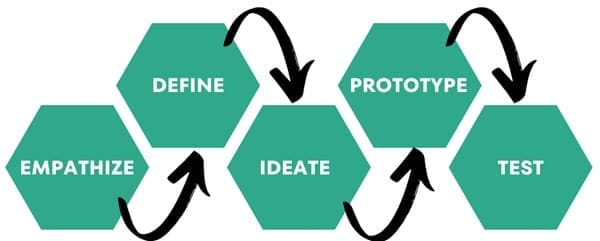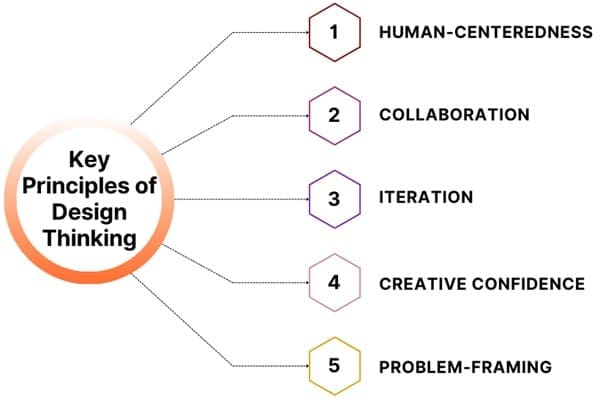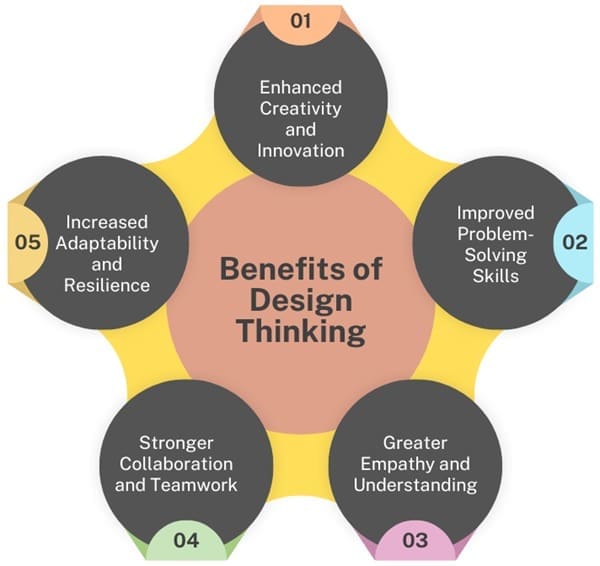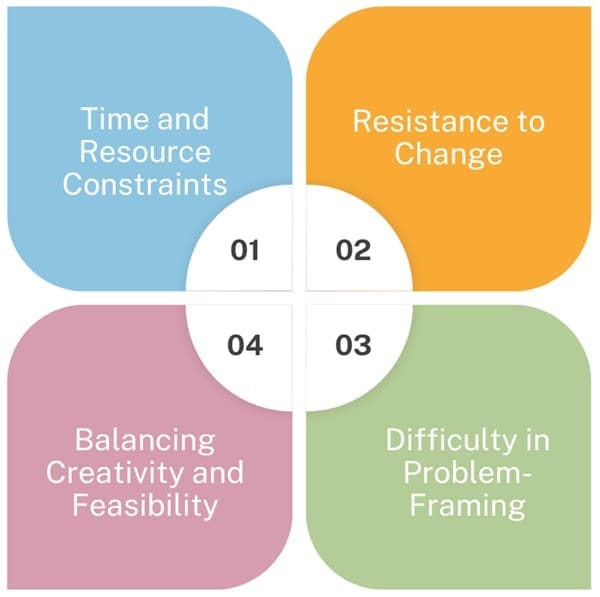In traditional educational settings, students are often encouraged to provide the “right” answers to predetermined questions. This approach, while effective in certain contexts, can stifle creativity and discourage the exploration of multiple solutions to complex problems.
Design Thinking (DT) offers a stark contrast to this traditional model by promoting an environment where students are empowered to explore, experiment, and innovate without the fear of being wrong.
This methodology focuses on real-world problems that often do not have straightforward solutions, thereby fostering a mindset of curiosity, collaboration, and resilience.
Table of contents
- What is Design Thinking?
- Phases of Design Thinking
- Problem with Ingrained Patterns of Thinking
- Example of Creative Problem-Solving
- Power of Storytelling in Design Thinking
- Design Thinking as “Outside the Box” Thinking
- Iterative Nature of Design Thinking
- Key Principles of Design Thinking
- Design Thinking in Education
- Benefits of Design Thinking
- Challenges of Design Thinking
- Final Words
- Related Articles
What is Design Thinking?
Design Thinking is a human-centred approach to problem-solving that emphasizes creativity and innovation. It involves understanding the user’s needs, exploring potential solutions through brainstorming and iteration, and ultimately arriving at a solution that best fits the user’s needs.
Unlike traditional problem-solving methods, which often focus on finding a single “correct” answer, Design Thinking encourages the exploration of multiple possible solutions, recognizing that complex problems often require complex and nuanced answers.
Origin and Evolution
Design Thinking has its roots in the creativity studies conducted by psychologists in the 1940s and 1950s. These studies inspired the development of various creativity techniques, which designers initially adopted for product design, with a primary focus on aesthetics.
Over time, professionals expanded the principles of Design Thinking beyond design. They applied these principles in various fields, including product and business model innovation, entrepreneurial idea development, and strategic management.
Today, people recognize Design Thinking as a powerful methodology. Design Thinking tackles some of the most pressing challenges of our time. It addresses issues such as clean energy transitions and climate change mitigation.
Phases of Design Thinking

There are various models of Design Thinking, each with its own set of phases, ranging from three to seven stages. However, all these models share the same fundamental principles, which were first described by Nobel Prize laureate Herbert Simon in his 1969 work The Sciences of the Artificial.
The Hasso-Plattner Institute of Design at Stanford proposed the five-phase approach, which has become the most widely recognized model. People commonly know this model as d.school. The five phases are:
- Empathize: Understanding the users’ needs by putting ourselves in their shoes.
- Define: Clearly articulating the problem by synthesizing the insights gained during the Empathize phase.
- Ideate: Generating a wide range of ideas by challenging existing assumptions and exploring new possibilities.
- Prototype: Creating tangible representations of the ideas to explore their viability.
- Test: Evaluating the prototypes with users, refining them based on feedback, and iterating as necessary.
It’s important to note that these phases are not always sequential. They can occur in parallel, and the process often requires revisiting earlier stages based on new insights gained during prototyping and testing. This non-linear, iterative nature is what makes Design Thinking so powerful in driving innovation.
Essence of Empathy in Design Thinking
Empathy is the cornerstone of Design Thinking. By truly understanding and empathizing with the user, we can design solutions that are not only functional but also emotionally resonant. This phase involves deep research, observation, and engagement with the users to gain insights into their experiences, pain points, and desires.
Empathy allows us to see the world through the eyes of the user, which is crucial in redefining the problem from a human-centered perspective. It challenges us to move beyond our assumptions and consider the emotional and psychological aspects of the user experience.
This human-centric approach ensures that the solutions we develop are grounded in a real understanding of the users’ needs and contexts.
Defining the Problem
Once we have a deep understanding of the user, the next step is to define the problem clearly. This phase involves synthesizing the insights gained during the Empathize phase to articulate a clear and concise problem statement. The problem definition guides us through the process, ensuring that we align the solutions with users’ needs.
In this phase, it’s crucial to challenge the initial assumptions about the problem. Often, the problem we set out to solve is not the root issue but rather a symptom of a deeper underlying challenge. By questioning and reframing the problem, we can uncover new opportunities for innovation that might not have been apparent at first glance.
Ideation
With a clear problem definition in hand, the next phase is ideation. This is where creativity takes center stage. The goal of the Ideate phase is to generate as many ideas as possible, without judgment or constraints. This phase is all about thinking outside the box, challenging existing paradigms, and exploring new possibilities.
During ideation, participants frequently use brainstorming as a common technique. They are encouraged to share any and all ideas, regardless of how wild or unconventional those ideas may seem. The emphasis is on quantity over quality at this stage, as even the most outlandish ideas can spark insights that lead to innovative solutions.
Ideation is a collaborative process that benefits from diverse perspectives. By involving a multidisciplinary team, we can leverage different ways of thinking and expertise, leading to a richer pool of ideas.
Prototyping
Once we have a range of ideas, the next step is to bring them to life through prototyping. Prototyping is the process of creating tangible representations of ideas, whether they are physical products, digital interfaces, or service experiences.
The goal of prototyping is not to create a finished product but to explore the viability of the ideas and to learn through making.
Prototypes can take many forms, from simple sketches and paper models to more sophisticated digital simulations. The key is to create something that can be tested and iterated upon. Prototyping allows us to explore different aspects of the solution, identify potential flaws, and refine the ideas before moving on to the final implementation.
Testing
The final phase of Design Thinking is testing. In this phase, real users test the prototypes to gather feedback and insights. Testing occurs iteratively, not just once. The prototypes are continuously refined based on the feedback received.
Testing helps to validate the ideas and ensure that they meet the users’ needs and expectations. It also provides an opportunity to uncover any issues or challenges that were not apparent during the earlier phases. By iterating on the prototypes and testing them with users, we can ensure that the final solution is both effective and user-friendly.
Problem with Ingrained Patterns of Thinking
One of the biggest challenges in innovation is overcoming ingrained patterns of thinking. As humans, we naturally develop schemas—mental models based on our experiences and knowledge. These schemas help us quickly navigate familiar situations, but they can also hinder our ability to see problems from a new perspective.
Ingrained thinking patterns can lead to solutions that are constrained by past experiences and assumptions. This is where Design Thinking shines, as it encourages us to challenge these patterns and think outside the box.
By questioning the status quo and exploring alternative ways of thinking, we can break free from the limitations of our schemas and discover innovative solutions.
Example of Creative Problem-Solving
A classic example of creative problem-solving that illustrates the power of thinking outside the box involves a truck driver who became stuck under a low bridge. As the truck caused massive traffic problems, experts and engineers debated various complex solutions to dislodge the vehicle, such as dismantling parts of the truck or chipping away at the bridge.
However, a young boy passing by offering a simple yet ingenious solution: “Why not just let the air out of the tyres?” The experts had overlooked this suggestion, but it allowed the truck to drive free with minimal damage.
This story highlights how ingrained thinking patterns can prevent us from seeing simple solutions and how a fresh perspective can lead to innovative outcomes.
Power of Storytelling in Design Thinking
Storytelling is a powerful tool in Design Thinking. Stories help us connect with the human experience, providing concrete details that inspire ideas and solutions. By framing problems and solutions in the context of real people’s lives, storytelling makes abstract concepts more relatable and actionable.
In Design Thinking, you can use storytelling to communicate users’ needs, the challenges they face, and the impact of potential solutions. This approach fosters empathy and understanding among the team. It also ensures that everyone aligns in their problem-solving approach.
Design Thinking as “Outside the Box” Thinking
Design Thinking challenges conventional problem-solving methods, earning it the label “outside the box” thinking. It pushes us to break away from familiar approaches. Instead, it encourages exploring new ways of thinking that aren’t restricted by traditional constraints.
At the heart of this approach is the desire to improve products and services by deeply understanding how users interact with them and by questioning the assumptions that underlie their design. The process involves falsifying previous assumptions, testing them to potentially disprove them. This leads to more innovative solutions.
Iterative Nature of Design Thinking
One of the key aspects of Design Thinking is its iterative nature. The process is not linear; it involves continuous cycles of prototyping, testing, and refining. This iterative approach allows for constant learning and improvement, ensuring that the final solution is the best possible outcome.
The iterative process also encourages flexibility and adaptability. As new insights are gained through testing, the team can pivot and explore new directions, leading to solutions that are more responsive to the users’ needs.
Key Principles of Design Thinking

Several key principles underpin the Design Thinking methodology, each of which contributes to its effectiveness as a problem-solving approach.
- Human-Centeredness: Design Thinking is fundamentally about understanding and addressing the needs of the user. This human-centered approach ensures that the solutions developed are not only innovative but also relevant and effective.
- Collaboration: Design Thinking is inherently collaborative, bringing together diverse perspectives and expertise to tackle complex problems. By working in multidisciplinary teams, participants can leverage a wide range of skills and knowledge to arrive at more holistic and innovative solutions.
- Iteration: The iterative nature of Design Thinking allows for continuous refinement and improvement of ideas. By repeatedly testing and refining prototypes, designers can arrive at solutions that are both effective and feasible.
- Creative Confidence: Design Thinking encourages participants to embrace creativity and take risks. The emphasis on quantity over quality in the ideation stage, combined with the iterative nature of the process, helps to reduce the fear of failure and build creative confidence.
- Problem-Framing: Design Thinking places a strong emphasis on properly defining the problem before jumping to solutions. Careful problem-framing ensures that the solutions address the right issues. It also aligns them with the user’s needs.
Design Thinking in Education
Design Thinking is increasingly being recognized as a valuable approach to education. It is particularly effective in fostering creativity, critical thinking, and problem-solving skills. By encouraging students to take ownership of their learning and engage with real-world problems, Design Thinking can help to cultivate a more innovative and resilient mindset.
In the classroom, Design Thinking can encourage students to work collaboratively and think creatively. It emphasizes embracing the iterative nature of the learning process rather than focusing solely on finding the “right” answer. Students are encouraged to explore multiple possibilities, test their ideas, and learn from their failures.
This approach not only helps to develop important skills but also fosters a more engaging and dynamic learning environment.
Benefits of Design Thinking

Design Thinking offers a wide range of benefits, both for individuals and organizations. Some of the key advantages include:
- Enhanced Creativity and Innovation: By encouraging out-of-the-box thinking and reducing the fear of failure, Design Thinking helps to unleash creativity and drive innovation.
- Improved Problem-Solving Skills: The iterative nature of Design Thinking allows participants to develop more effective problem-solving skills, as they learn to approach challenges from multiple angles and refine their ideas based on feedback.
- Greater Empathy and Understanding: The emphasis on empathy in Design Thinking helps to build a deeper understanding of the user’s needs and challenges, leading to more relevant and effective solutions.
- Stronger Collaboration and Teamwork: Design Thinking fosters a collaborative approach to problem-solving, bringing together diverse perspectives and expertise to tackle complex challenges.
- Increased Adaptability and Resilience: The iterative nature of Design Thinking helps to build adaptability and resilience, as participants learn to embrace failure as a valuable part of the learning process.
Challenges of Design Thinking

While Design Thinking offers many benefits, it is not without its challenges. Some of the common obstacles include:
- Time and Resource Constraints: The iterative nature of Design Thinking can be time-consuming, and the process often requires significant resources in terms of time, materials, and expertise.
- Resistance to Change: Design Thinking often requires a shift in mindset. This is especially true for organizations accustomed to more traditional approaches to problem-solving. Overcoming resistance to change can be a significant challenge.
- Difficulty in Problem-Framing: Properly defining the problem is one of the most challenging aspects of Design Thinking. Without a clear and well-defined problem statement, it can be difficult to develop effective solutions.
- Balancing Creativity and Feasibility: While Design Thinking encourages creativity, it is also important to ensure that the solutions developed are feasible and practical. Balancing creativity with feasibility can be a delicate process.
Final Words
Design Thinking is a powerful methodology that offers a fresh approach to problem-solving, emphasizing creativity, collaboration, and empathy. By placing the user at the center of the process and encouraging an iterative approach to innovation, Design Thinking can help individuals and organizations to develop more effective and relevant solutions to complex challenges.
In education, Design Thinking offers a valuable framework for fostering creativity, critical thinking, and problem-solving skills. By encouraging students to take ownership of their learning and engage with real-world problems, Design Thinking can help to cultivate a more innovative and resilient mindset.
As we face increasingly complex challenges in the modern world, from climate change to technological disruption, the ability to think creatively and collaboratively has never been more important.
Design Thinking offers a powerful tool for unlocking this potential and driving meaningful innovation in a wide range of fields. Whether in the classroom, the boardroom, or the lab, Design Thinking has the potential to transform the way we approach problems and create solutions, making it an essential skill for the 21st century.

About Six Sigma Development Solutions, Inc.
Six Sigma Development Solutions, Inc. offers onsite, public, and virtual Lean Six Sigma certification training. We are an Accredited Training Organization by the IASSC (International Association of Six Sigma Certification). We offer Lean Six Sigma Green Belt, Black Belt, and Yellow Belt, as well as LEAN certifications.
Book a Call and Let us know how we can help meet your training needs.



















